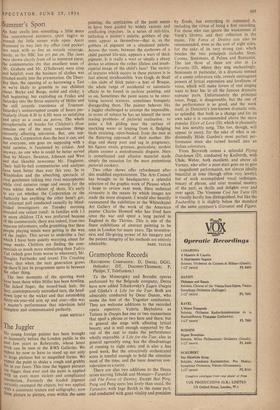The Juggler
No young foreign painter has been brought so insistently before the London public in the Past few years as Rebeyrolle, whose latest work can be seen at the RWS Galleries. We expect by now to have to stand up not only to large pictures but to magnified forms. We expect the paint to shake a rough and grubby fist in our faces. This time the bi,ggest pictures are bigger than ever and the paint is applied with an even more violent and complicated mannerism. Formerly the loaded pigment certainly swamped the objects, but was applied froth a consistent texture and calligraphy; now '43111 picture to picture, even within the same painting, the application of the paint seems to have been guided by widely various and conflicting impulses. In a series of still-lifes, including a painter's palette, gobbets of pig- ment appear as themselves—that is, as the gobbets of pigment on a simulated palette. Across the room, between the eyebrows of a child painted life-size, appears a wart of thick pigment. Is it really a wart or simply a cheap device to animate the rather lifeless and insub- stantial image of 'the child's face? The variety of textures which occurs in these pictures is in fact almost inexhaustible. Van Gogh, de Stael —his slabs of thick paint—a hint of Braque, the whole range of accidental or automatic effects to be found in tachiste painting, and so on. Sometimes the paint seems to be simu- lating natural textures, sometimes brusquely disregarding them. The painter behaves like a juggler challenged to attempt the impossible. In terms of subject he has set himself the most teasing problems of pictorial realisation : to paint a fish gliding near the surface of sparkling water or leaping from it, fledgling birds straining, open-beaked, from the nest at the fluttering approach of their mother. His dogs and sheep pant and sag in pregnancy; his figures strain, grimace, gesticulate; modest plants assume a melodramatic disguise. Here is complicated and allusive material made simply the occasion for the most pretentious pictorial cookery. Two other shows offer refreshment after this muddled expressionism. The Arts Council has brought to its headquarters a splendid selection of the graphic work of Picasso which I hope to review next week. Here technical virtuosity is the means by which images are made the more eloquent. I would also heartily recommend the exhibition at the Whitechapel Art Gallery of the work of the American painter Charles Howard who has lived here since the war and spent a long period in England in the Thirties. This is one of the finest exhibitions of abstract painting to be seen in London for many years. The inventive- ness and life-giving power of his imagery and the patient integrity of his methods are entirely


































 Previous page
Previous page